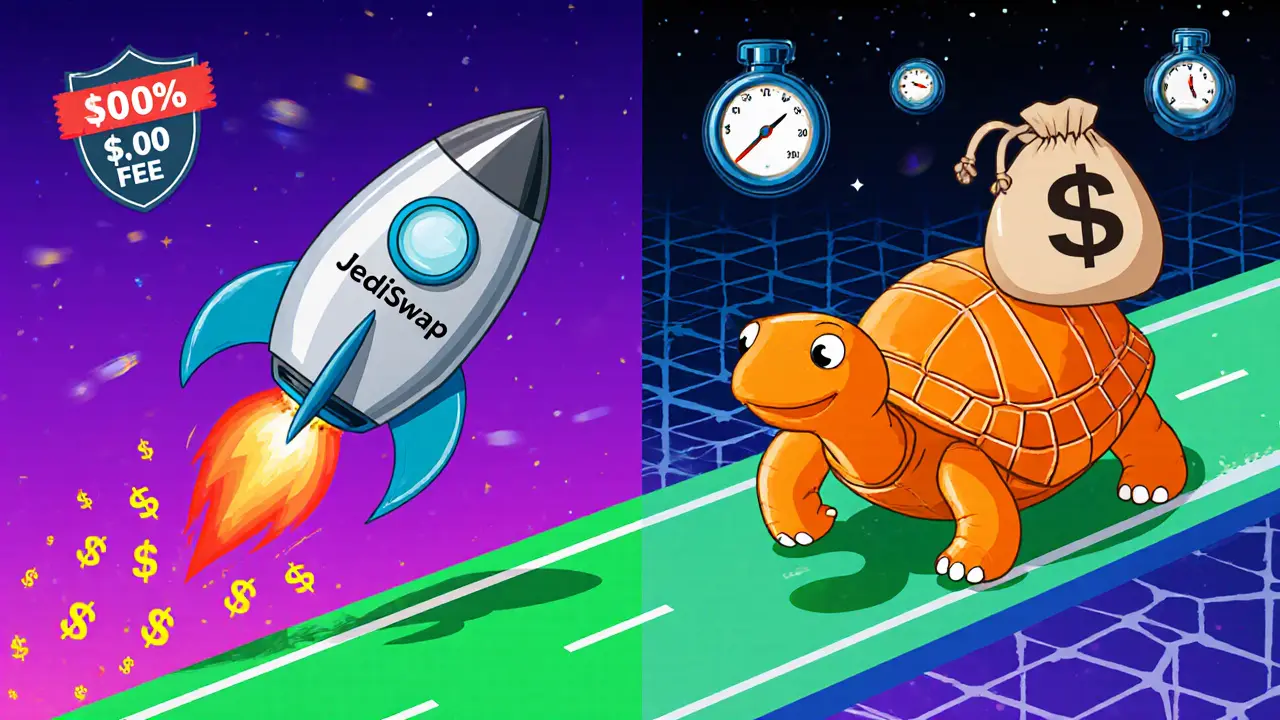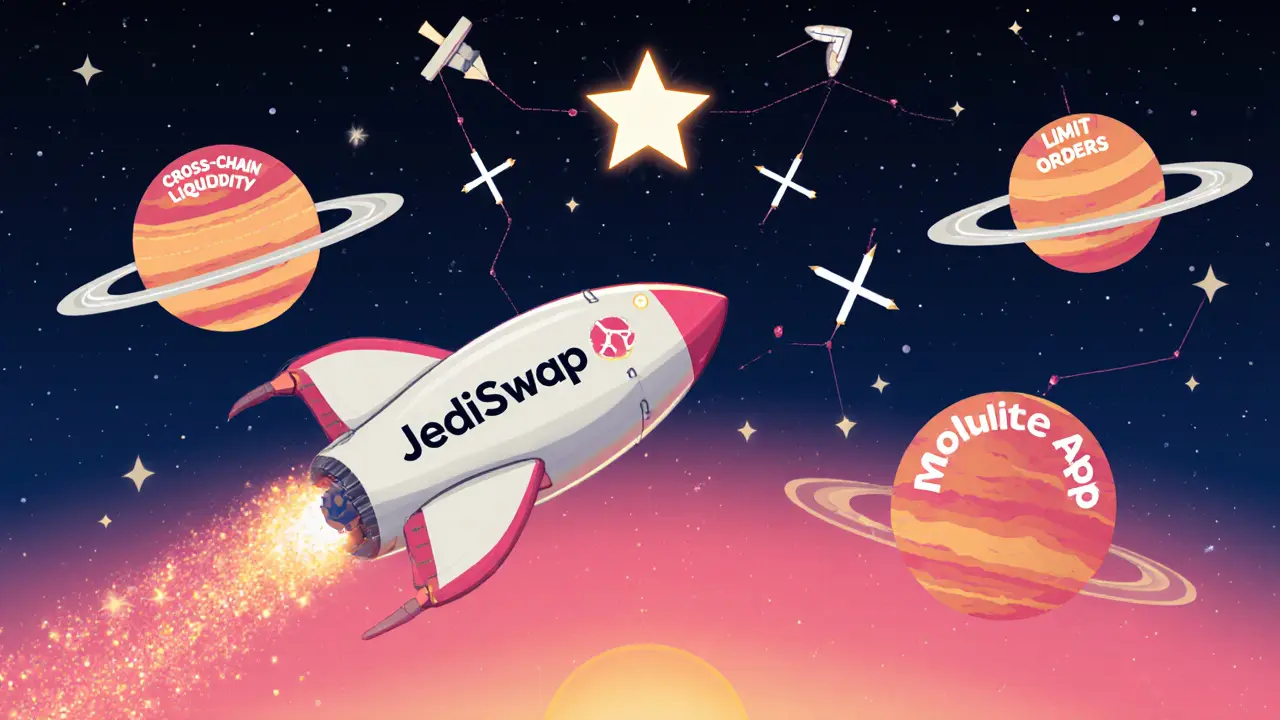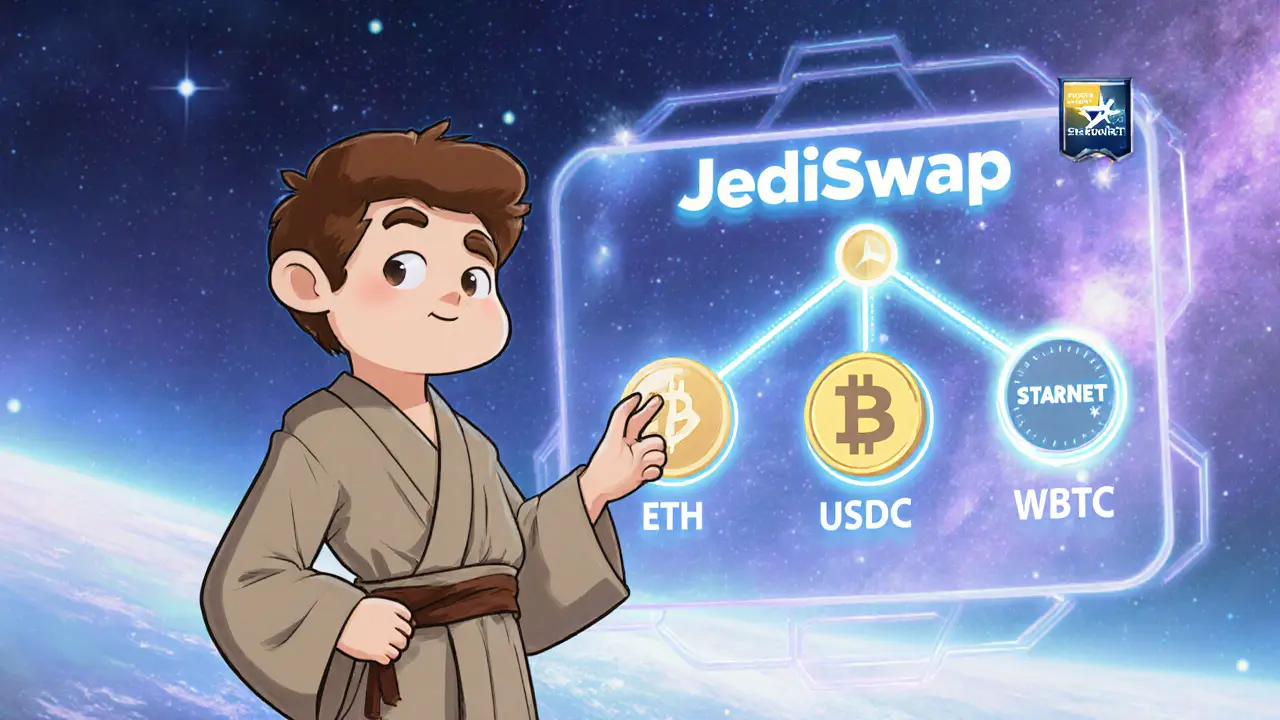JediSwap Fee Calculator
Fee Comparison
JediSwap fees average $0.03 (0.0001 ETH) per swap - about 99.97% cheaper than Uniswap during peak congestion.
When this calculator is most useful:
- High-frequency traders
- Arbitrage opportunities
- Small-volume trades (under $100)
- Trades involving ETH, USDC, DAI, or WBTC
If you’ve been chasing the dream of near‑zero gas costs while still enjoying Ethereum‑level security, you’ve probably heard the name JediSwap as a StarkNet‑based decentralized exchange (DEX) that promises ultra‑low fees and fast confirmations. In this review we’ll walk through what the platform actually delivers, how it stacks up against the big players, and whether it’s worth adding to your DeFi toolbox.
Key Takeaways
- Fees average $0.03 per swap, roughly 99.97% cheaper than Uniswap on Ethereum mainnet.
- Only 7 tokens and 13 pairs are available - a major limitation for traders seeking variety.
- Transaction speed averages 1.2 seconds with 99.98% uptime, thanks to StarkNet validity‑rollups.
- Security has been audited by ConsenSys Diligence and OpenZeppelin with no major incidents to date.
- On‑boarding is steep for newcomers; you’ll need a StarkNet‑compatible wallet like Argent X.
How JediSwap Works
JediSwap runs as an Automated Market Maker (AMM) using the classic constant product formula (x*y = k). The smart contracts are written in Cairo, StarkNet’s native language, and were compiled to a TypeScript front‑end for the web UI. When you swap, you’re not dealing with an order book - the pool’s algorithm automatically finds the best price based on current liquidity.
Because the contracts sit on StarkNet, every transaction inherits Ethereum’s security guarantees while the L2 layer handles proof aggregation. In practice that means you pay a fraction of the gas you’d spend on the Ethereum mainnet, and the network confirms a trade in about a second.
Performance, Fees & Liquidity
According to data from CoinGecko (Oct 2025), JediSwap’s 24‑hour volume hovers around $2.7 million. That’s tiny next to Uniswap’s $1.2 billion, but the platform’s niche focus shines in fee savings. A typical swap costs ~0.0001 ETH (≈$0.03), while Uniswap during peak congestion can charge up to 0.3 ETH (≈$90). For high‑frequency traders or arbitrageurs, the cumulative savings are massive.
Liquidity, however, is a double‑edged sword. With only 7 tokens - ETH, USDC, DAI, WBTC, LINK, AAVE, and MKR - the total pool depth is limited. Slippage stays low for those assets but you’ll quickly run into thin order books if you stray into niche tokens.
Security Audits & Risk Profile
JediSwap’s code base has passed two major audits: ConsenSys Diligence (report #CD‑2022‑087) and OpenZeppelin (report OZ‑2023‑045). Both auditors highlighted the robustness of StarkNet’s validity proofs and Cairo’s formal verification, giving the platform an overall security rating of 4.2/5 from ConsenSys analyst Sarah Jamie Lewis.
No major hacks have been reported in its 2.5‑year history, and the platform’s uptime of 99.98% over the past year matches the reliability promised by StarkNet’s status page. The biggest risk, according to security trackers, is ecosystem‑wide downtime on StarkNet itself - a 72‑hour outage in March 2024 halted all trading on JediSwap.

User Experience: On‑boarding & Everyday Use
Getting started requires a StarkNet‑compatible wallet. Argent X is the most recommended because it integrates directly with the bridge UI. The typical flow looks like this:
- Install Argent X (or Braavos) as a browser extension or mobile app.
- Bridge assets from Ethereum to StarkNet via StarkGate or Orbiter Finance (takes 7‑15 minutes).
- Approve the token for use on JediSwap - a single transaction per asset.
- Swap, add liquidity, or withdraw directly from the DEX UI.
For seasoned DeFi users the whole process takes about 8‑12 hours of learning. Newbies often report 20‑30 hours of trial‑and‑error, mostly because wallet connection errors pop up frequently (41% of first‑time users hit at least one error).
Support is decent - a 24/7 live chat averages 8‑minute response times during normal periods, but spikes to 45 minutes during market turbulence.
How JediSwap Stacks Up Against the Competition
| Feature | JediSwap | Uniswap v3 | Curve Finance | PancakeSwap |
|---|---|---|---|---|
| Underlying L2 | StarkNet (validity rollups) | Ethereum L1 | Ethereum L1 | Binance Smart Chain |
| Avg. fee per swap | $0.03 (0.0001 ETH) | $90 (0.3 ETH) | $0.08 (stable‑pair optimized) | $0.12 (BSC gas) |
| 24h volume | $2.7 M | $1.2 B | $420 M | $32.4 M |
| Token count | 7 | 1,850+ | ≈300 (stable‑focused) | ≈400 |
| Liquidity (USD) | ≈$15 M | $12 B | $5 B | $600 M |
The table makes it clear: JediSwap excels on fees and transaction speed, but it can’t compete on token breadth or raw liquidity. If you need a wide array of assets, Uniswap or PancakeSwap wins. If you’re trading a handful of high‑volume tokens and want to shave off fees, JediSwap is hard to beat.
Pros & Cons Checklist
- Pros
- Ultra‑low fees - perfect for arbitrage and frequent swaps.
- Fast confirmations (~1.2 s) and high uptime.
- Strong security model backed by Ethereum L1 guarantees.
- Recent v3.2.1 upgrade adds concentrated liquidity pools.
- Cons
- Very limited token selection - only 7 coins as of Oct 2025.
- Steep learning curve for users unfamiliar with StarkNet wallets.
- Liquidity depth is modest, leading to higher slippage for large trades.
- Reliance on a single L2 means network‑wide outages affect the DEX.

Roadmap & Future Outlook
JediSwap’s team has laid out an ambitious roadmap. Q1 2026 will bring cross‑chain liquidity pools, Q2 2026 will add limit‑order functionality, and Q4 2026 promises a native mobile app. StarkNet itself aims to boost throughput to 1,000 TPS by Q3 2026, which would directly address the current 100 TPS ceiling limiting JediSwap’s scaling potential.
Analysts at Delphi Digital see StarkNet‑based DEXs capturing up to 15% of Ethereum L2 volume by 2026 if adoption accelerates. However, Electric Capital warns that fragmentation across L2 solutions could stall growth unless projects like JediSwap improve cross‑chain bridges.
Bottom Line: Should You Use JediSwap?
If you’re a trader who values tiny fees above everything else and you’re comfortable navigating StarkNet wallets, JediSwap review shows the platform delivers on its promises. The trade‑off is a narrow token list and a steeper onboarding curve. For most casual DeFi users who need a broad market and easy entry, a mainstream DEX like Uniswap or PancakeSwap remains a better fit. But for high‑frequency, low‑margin strategies, JediSwap is a compelling, cost‑effective niche.
Frequently Asked Questions
What wallets work with JediSwap?
You need a StarkNet‑compatible wallet. The most popular choices are Argent X, Braavos, and Voyager. These extensions let you bridge assets and sign transactions on StarkNet.
How much does a typical swap cost on JediSwap?
Fees average 0.0001 ETH, which is about $0.03 at current prices. That’s roughly 99.97% cheaper than swapping on Uniswap during peak congestion.
Is JediSwap safe to use?
The protocol has undergone audits by ConsenSys Diligence and OpenZeppelin, and it inherits Ethereum’s security via StarkNet validity proofs. No major hacks have been recorded, but keep an eye on StarkNet network health.
Can I provide liquidity on JediSwap?
Yes. JediSwap supports standard AMM liquidity provision as well as concentrated liquidity pools introduced in v3.2.1. You’ll need to supply both assets of the pair to earn fee rewards.
What’s the roadmap for new features?
The team plans cross‑chain liquidity pools in early 2026, limit orders in mid‑2026, and a mobile app later that year. StarkNet’s planned throughput boost will also improve overall performance.

20 Comments
Niki Burandt
OMG this is literally the future 🤯 I swapped 50 times yesterday and spent less than a dollar in fees. Uniswap is just a bloated dinosaur at this point. 🚀
Chris Pratt
I came from India and honestly, StarkNet felt like magic. Argent X was a pain at first but once it clicked? Worth every minute. 🙌
Karen Donahue
I don't know why people are so excited about this. Only seven tokens? That's not a DEX, that's a hobby project. And don't even get me started on the wallet onboarding - it's a nightmare for normal people who just want to buy ETH and call it a day. This is why crypto remains a niche for tech bros who think they're geniuses.
Bert Martin
If you're new to L2s, start small. Try swapping 0.01 ETH just to see how fast it goes. Once you feel the speed, you'll understand why people are excited. No rush - take your time.
Ali Korkor
Bro this thing is insane. I do 20 swaps a day and my gas bill is like $0.60. Uniswap was killing me. JediSwap is the real MVP. Just get Argent X and go. You won't regret it.
madhu belavadi
I tried this and felt so empty after. Like I spent hours setting it up and then only had 7 coins to trade. Why do I even bother? This feels like a trap.
Dick Lane
The fee difference is wild. I used to pay $80 a week on Uniswap now I pay $2 on JediSwap. That's like going from a sports car to a bicycle but the bicycle gets you there faster and doesn't need gas
Norman Woo
they're tracking us through the wallet. StarkNet is just a front for the feds. why do you think they made it so fast? so they can monitor every single trade. and those audits? totally fake. i bet they own both firms
Serena Dean
You got this! The wallet setup is rough at first but once you do it once, it’s smooth sailing. And the fees? Life-changing for active traders. Don’t let the small token list scare you - start with ETH, USDC, DAI. You’ll be amazed how much you can do with just those.
James Young
This review is way too soft. Only $2.7M volume? That’s a joke. And you call that security? Anyone with half a brain knows StarkNet is just a glorified sidechain pretending to be L2. Real DeFi is on Ethereum. This is just a toy for people who can't handle real gas fees.
Chloe Jobson
StarkNet’s validity proofs + Cairo’s formal verification = enterprise-grade safety. The liquidity constraints are structural, not fatal. Concentrated pools in v3.2.1 are a game-changer for LPs.
Andrew Morgan
I remember when I first tried to bridge my ETH and it just… disappeared for 20 minutes. I thought I got scammed. Then it showed up. I cried. Not because I lost money - because I finally got it. This isn’t just tech. It’s a vibe.
Michael Folorunsho
Why are Americans so obsessed with this StarkNet nonsense? Real trading happens on BSC or Ethereum. This is just another Silicon Valley fantasy. We don't need your overhyped L2s here in the real world.
Roxanne Maxwell
I'm so glad someone finally broke this down. I was scared to try it because of all the wallet stuff but your explanation made it feel doable. Thank you for not making me feel dumb for not knowing Cairo.
Jonathan Tanguay
Ive been using jediswap since launch and i can tell you its the future but people dont get it they think its just another dex but its way more than that the cairo language is like the new python for blockchain and the 1.2 sec confirmations are insane i did 1200 swaps last week and my total cost was 12 cents and uniswap wouldve cost me 3600 dollars i mean seriously why are you still on l1
Ayanda Ndoni
I tried this and it was fine I guess but I just wanted to know if you guys ever feel like you're being watched? Like every time I swap I feel like someone's taking notes. I'm not paranoid I just know how these things work.
John Murphy
I'm curious how the concentrated liquidity pools work in practice. Do they auto-adjust like Uniswap v3 or do you have to manually set ranges? Anyone have experience?
Zach Crandall
The formal verification of Cairo contracts is a technical marvel. However, the UX remains a significant barrier to mass adoption. One must question whether technological superiority alone can overcome usability inertia.
Akinyemi Akindele Winner
This is why Africa is gonna eat your lunch one day. You all got stuck on Ethereum like it's holy scripture while we were out here building on cheaper chains. JediSwap? Cute. Wait till you see what Lagos devs drop next month.
Niki Burandt
LMAO @745 you did 1200 swaps?? Bro you're either a bot or a masochist 😂 I do 20 a day and I'm already addicted. But yeah 12 cents?? That's the sweetest thing I've seen all year 💸